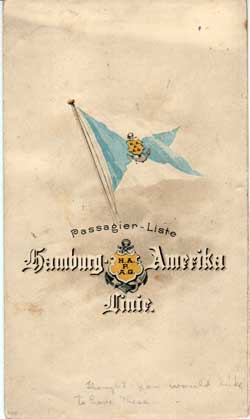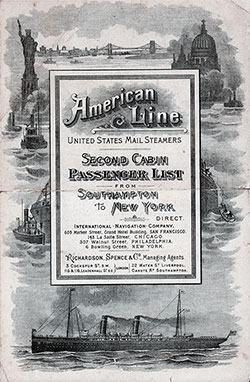Ellis Island/NY Barge Office Passenger Lists - 1897
Passenger lists for 1897 represent the souvenir list provided to the passengers of each cabin class (and other classes). Many of these souvenir passenger lists have disappeared over the years. Our collection primarily covers North American and European ports and ports in Australia and South Africa.
Our collection contains samples of passenger lists produced and printed by the steamship lines. These lists are often used to illustrate family history books for immigrants from this period.
Coveted by collectors and genealogists, souvenir passenger lists often offered beautiful graphical covers and information not found in official manifests because they focused on the journey rather than the destination.
Note: The Barge Office was used as New York's immigrant processing center from 19 April 1890 to 31 December 1891 and from 15 June 1897 to 16 December 1900.

1897-06-25 SS Mongolian Passenger List
Steamship Line: Allan-State Line Royal Mail Steamers
Class of Passengers: Cabin Class
Date of Departure: 25 June 1897
Route: New York to Glasgow via Londonderry
Commander: Captain A. G. Braes

1897-07-17 RMS Numidian Passenger List
Steamship Line: Allan Line
Class of Passengers: Saloon
Date of Departure: 17 July 1897
Route: Montréal to Liverpool
Commander: Captain Angus McNicol

1897-08-12 SS Circassia Passenger List
Steamship Line: Anchor Steamship Line
Class of Passengers: Saloon
Date of Departure: 12 August 1897
Route: Glasgow to New York via Moville
Commander: Captain G. C. Boothby

1897-08-26 SS Auguste Victoria Passenger List
Steamship Line: Hamburg Amerika Linie / Hamburg American Line (HAPAG)
Class of Passengers: Cabin
Date of Departure: 26 August 1897
Route: Hamburg to New York via Southampton
Commander: Captain C. Kaempff

1897-10-02 SS St. Louis Passenger List
Steamship Line: American Line
Class of Passengers: Cabin
Date of Departure: 2 October 1897
Route: Southampton to New York
Commander: Captain William G. Randle

1897-11-18 SS Parisian Passenger List
Steamship Line: Allan Line
Class of Passengers: Saloon
Date of Departure: 18 November 1897
Route: Liverpool to Halifax and Portland, ME
Commander: Captain R. Barrett, LT. R.N.R.
Please help us make our passenger list collection more complete. We would appreciate a digital copy if you have an 1897 souvenir passenger list. Please email us at history@ggarchives.com.
Recap and Summary of the Ellis Island Passenger Lists - 1897 Index Page
The Ellis Island Passenger Lists for 1897 provide a fascinating look at transatlantic ocean travel, featuring a mix of luxury, business, and emigrant voyages during a transitional time in U.S. immigration history. These souvenir passenger lists, often beautifully illustrated, were given to passengers as keepsakes and primarily document cabin and saloon-class travelers, rather than the steerage-class immigrants who made up the majority of Ellis Island arrivals.
A key historical note for 1897 is the temporary closure of Ellis Island due to a fire, which led to the reopening of the Barge Office as New York’s immigration processing center from June 15, 1897, to December 16, 1900. This shift underscores the challenges of managing large-scale immigration and the growing demand for more efficient processing facilities.
The steamship lines featured in this collection include Allan Line, Anchor Line, Hamburg-Amerika Line, and the American Line, with voyages between New York, Glasgow, Liverpool, Hamburg, Southampton, and Canada. Notably, Canadian routes are represented, highlighting the importance of Halifax and Portland, Maine, as alternative entry points for immigrants and travelers.
Notable Highlights from 1897 Passenger Lists
- SS Mongolian (Allan-State Line) – 25 June 1897
- Route: New York to Glasgow via Londonderry
- Passenger Class: Cabin
- Commander: Captain A. G. Braes
- Significance: The New York-Glasgow route was crucial for returning Scottish and Irish emigrants, business travelers, and professionals. The stop in Londonderry (Ireland) indicates an ongoing Irish presence in transatlantic migration, though by the late 1890s, Irish emigration had slowed compared to previous decades.
- RMS Numidian (Allan Line) – 17 July 1897
- Route: Montréal to Liverpool
- Passenger Class: Saloon
- Commander: Captain Angus McNicol
- Significance: This voyage showcases Canada’s growing role in transatlantic travel. Montréal was a key hub for British and Irish emigrants, business travelers, and government officials, and the Liverpool connection remained vital for commerce and migration.
- SS Circassia (Anchor Line) – 12 August 1897
- Route: Glasgow to New York via Moville
- Passenger Class: Saloon
- Commander: Captain G. C. Boothby
- Significance: The Glasgow-Moville-New York route highlights Scottish and Irish migration, with Moville (Ireland) serving as an important embarkation point for Irish emigrants and seasonal workers traveling to America.
- SS Auguste Victoria (Hamburg-Amerika Line) – 26 August 1897
- Route: Hamburg to New York via Southampton
- Passenger Class: Cabin
- Commander: Captain C. Kaempff
- Significance: The Hamburg-Amerika Line (HAPAG) was one of the most important German steamship companies, and this voyage reflects the continued migration of Germans and Eastern Europeans to the U.S. The Southampton stop suggests that British passengers also boarded this voyage, showing the interconnected nature of European migration routes.
- SS St. Louis (American Line) – 2 October 1897
- Route: Southampton to New York
- Passenger Class: Cabin
- Commander: Captain William G. Randle
- Significance: The American Line was expanding its presence in transatlantic travel, competing with Cunard and White Star Line for both business travelers and emigrants. This voyage represents the continued increase in American-owned steamship companies carrying passengers between Europe and the U.S.
- SS Parisian (Allan Line) – 18 November 1897
- Route: Liverpool to Halifax and Portland, ME
- Passenger Class: Saloon
- Commander: Captain R. Barrett, LT. R.N.R.
- Significance: This is one of the few voyages in this collection bound for Canada and New England, demonstrating the importance of Halifax and Portland, Maine, as alternative immigration ports. Many British and Irish emigrants used Canada as a gateway to the U.S., often traveling overland.
Historical Context – Events Impacting Ocean Travel in 1897
1. Fire at Ellis Island – Temporary Closure and Reopening of the Barge Office
- On June 15, 1897, a fire destroyed Ellis Island’s wooden immigration buildings, leading to its closure.
- The Barge Office in Manhattan was reopened as a temporary immigration processing center until Ellis Island was rebuilt in 1900.
- This change created delays and overcrowding, affecting immigrant experiences upon arrival.
2. The Expansion of Canadian Immigration Routes
- The presence of the SS Numidian (Montréal to Liverpool) and SS Parisian (Liverpool to Halifax & Portland, ME) highlights Canada’s increasing role in transatlantic migration.
- Many British and Irish immigrants traveled to Canada before moving to the U.S., avoiding stricter American immigration laws.
3. Growth of German and Eastern European Migration
- The SS Auguste Victoria (Hamburg to New York) reflects Germany’s role as a key departure point for emigrants from Germany, Poland, and Russia.
- Many Jewish emigrants fleeing persecution in Eastern Europe used Hamburg-Amerika Line ships to reach America.
4. The Rise of American-Owned Steamship Companies
- The American Line was expanding aggressively, as seen with the SS St. Louis voyage.
- The U.S. was increasingly competing with British and German shipping companies, offering faster, more comfortable ships for both business and emigrant travel.
5. Decline in Irish Emigration, but Ongoing Scottish and English Migration
- While Irish emigration had slowed compared to previous decades, ships like the SS Mongolian and SS Circassia show that Scots and Irish still made up a significant portion of transatlantic passengers.
- The presence of Moville and Londonderry stops on these voyages highlights continued migration from Northern Ireland.
Final Thoughts
The Ellis Island Passenger Lists for 1897 offer a diverse and insightful look into transatlantic migration, capturing the impact of Ellis Island’s temporary closure, the expansion of Canadian routes, and the increasing presence of American steamship companies.
Key takeaways include:
- The fire at Ellis Island led to the reopening of the Barge Office as a temporary immigration center.
- Canada’s role in transatlantic migration was growing, with Halifax and Portland, Maine, serving as key entry points.
- German and Eastern European migration continued to rise, especially via Hamburg-Amerika Line.
- American steamship companies were expanding, competing with British and German lines.
- While Irish migration had slowed, Scottish and English migration remained strong, with frequent departures from Glasgow and Liverpool.
This collection serves as an important historical record, capturing the evolving nature of transatlantic travel just before the turn of the 20th century, as immigration laws became stricter and competition among ocean liners intensified.
